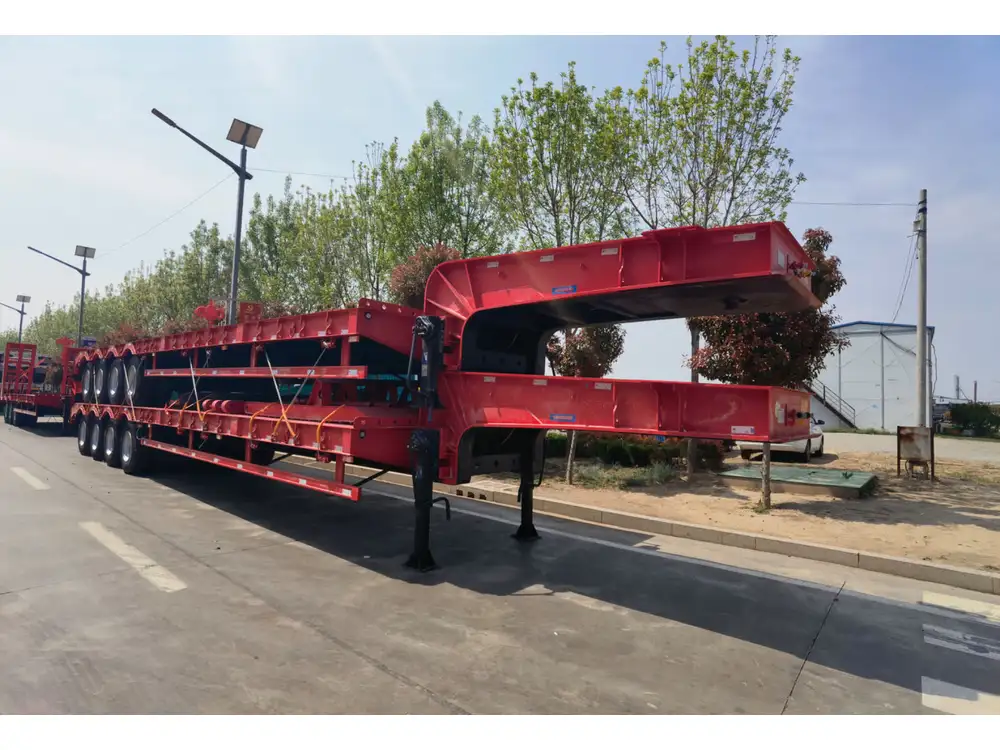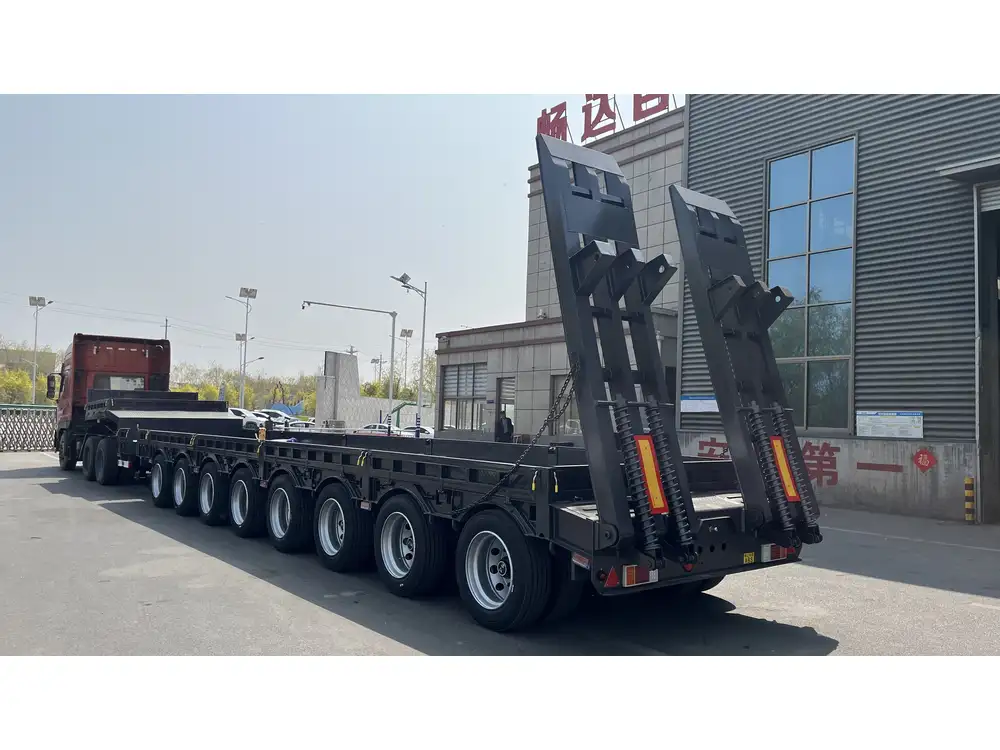Introduction: The Backbone of Freight Transport
In the ever-evolving world of logistics and freight transport, one question frequently arises among shippers, fleet operators, and manufacturers: how much weight can a 53 ft semi-trailer carry? This inquiry does not merely stem from curiosity; understanding weight capacity is critical for compliance, efficient loading, and maximizing profit margins in freight operations. The purpose of this article is to dissect the various factors that influence the maximum loading capabilities of 53 ft semi-trailers, ensuring stakeholders can optimize their operations effectively.
Understanding Gross Vehicle Weight Rating (GVWR)

What is GVWR?
The Gross Vehicle Weight Rating (GVWR) is the maximum weight a vehicle is rated to safely transport, including the weight of the vehicle itself, cargo, passengers, and additional equipment. For 53 ft semi-trailers, this rating is pivotal in determining payload capacity.
Factors Influencing GVWR
| Factor | Description |
|---|---|
| Trailer Construction | Materials (steel vs. aluminum), design integrity, and structural components significantly affect weight limits. |
| Axle Configuration | The number and type of axles (e.g., tandem vs. tri-axle) directly impact the weight distribution and carrying capacity. |
| Tire Specifications | Tires must suit the load rating defined for the axle; under or over-inflation can lead to premature failure. |
| Legal Regulations | Local and federal regulations dictate permissible weights; non-compliance can result in hefty fines and safety hazards. |
Typical GVWR of a 53 ft Semi-Trailer
Most 53 ft semi-trailers possess a typical GVWR ranging from 80,000 to 90,000 pounds. However, the actual maximum payload capacity depends on several interrelated factors, including regulations imposed by the Federal Motor Carrier Safety Administration (FMCSA).

Calculating Payload Capacity
The Formula: GVWR – (Truck Weight + Trailer Weight)
To ascertain the payload capacity, we can employ a straightforward formula:
- Payload Capacity = GVWR – (Truck Weight + Trailer Weight)
For example, if your tractor unit (truck) weighs 20,000 pounds and your empty trailer weighs 15,000 pounds with a GVWR of 80,000 pounds, the calculation looks like this:
- Payload Capacity = 80,000 – (20,000 + 15,000)
- Payload Capacity = 80,000 – 35,000 = 45,000 pounds
This demonstrates that a 53 ft semi-trailer can typically accommodate a payload of up to 45,000 pounds, assuming optimal conditions.
When Weight Distribution Matters
Effective weight distribution is crucial to maintaining vehicle stability. Unevenly loaded trailers may lead to dangerous handling characteristics and cause axle overloading, ultimately risking structural damage. The following table summarizes recommended payload distributions:
| Load Distribution Method | Recommended Load (%) | Benefits |
|---|---|---|
| Front-Heavy | 60 | Better traction for truck |
| Balanced | 50-50 | Optimal handling and stability |
| Rear-Heavy | 40 | Increased rear axle pressure, potential for trailer sway |

Compliance with Weight Regulations
Legal Load Limits
Across North America, various governing bodies impose restrictions on maximum weight limits to ensure safety and road integrity. For instance:
- Federal regulations (USA): 80,000 pounds maximum for combined truck and trailer, with specific axle limits.
- State regulations (USA): Allowed limits may vary; some states allow heavier loads under specific permits.
- Provincial regulations (Canada): Similarly, Canadian provinces have their own regulations reflecting load capacity and axle limits.
Being cognizant of these limitations is paramount for any logistics operation, as violations can lead to significant penalties and infrastructure wear.
Permits for Oversized Loads
Should your payload exceed normal limits, special permits are necessary. This section discusses different types of permits:
| Permit Type | Description |
|---|---|
| Single-Trip Permit | Allows a one-time trip exceeding standard limits. |
| Annual Permit | Permits numerous trips throughout the year for consistent overweight transport. |
| Specialized Load Permit | Necessary for loads deemed excessively heavy or oversized, requiring specific routing and safety precautions. |

Maximizing Efficiency: Best Practices for Loading
Utilizing Load Distribution Systems
Several systems are available to help with efficient load distribution. These include:
- Weight Sensors: Monitor the weight on each axle to prevent exceeding limits.
- Air Suspension Systems: Enhance stability during transit through effective weight dispersion.
Engage Loading Equipment
Using specialized loading equipment such as forklifts, pallet jacks, and cargo straps can significantly enhance the efficiency and safety of the loading process.

Periodic Checks and Maintenance
Regularly checking the integrity of the trailer’s frame, axles, and tires, as well as recalibrating weight sensors, enhances safety and compliance:
- Visual Inspections: Conduct thorough inspections before each haul.
- Tire Pressure Maintenance: Adhere to recommended tire pressure for optimal support based on load capacity.
Common Questions and Answers
What Happens If You Exceed the Weight Limit?
Exceeding the weight limit can lead to increased wear and tear on the truck and trailer, diminishing fuel efficiency, and elevating risks of accidents. Additionally, legal ramifications such as fines may occur.

Can a 53 ft Semi-Trailer Carry More Than 45,000 Pounds?
While a well-constructed 53 ft semi-trailer can accommodate heavier loads, it is subject to both the constraints of the GVWR and gears and brakes’ capabilities. Always prioritize compliance for safe transport.
What Are the Advantages of Using 53 ft Semi-Trailers?
The 53 ft semi-trailer boasts several benefits, including:
- Increased Payload Capability: Higher volume offers the potential to transport more goods at once.
- Versatile Application: Suitable for various sectors, including automotive, agriculture, and consumer goods.
- Cost Efficiency: Optimizes fuel consumption per load versus shorter trailers.
Conclusion: Ensuring Safe and Efficient Transportation
Understanding how much weight can a 53 ft semi-trailer carry is essential for effectively navigating the logistics landscape. Compliance, payload calculation, and weight management are vital components that play a significant role in maintaining operational efficiency and safety.
As logistics continues to grow in complexity, ensuring that all freight operators are equipped with expansive knowledge on trailer capacities can foster a safer, more efficient transportation ecosystem. When in doubt, consulting experts and regularly reviewing regulations can safeguard your operations against unexpected violations and enhance overall performance, paving the path to streamlined logistics success.



